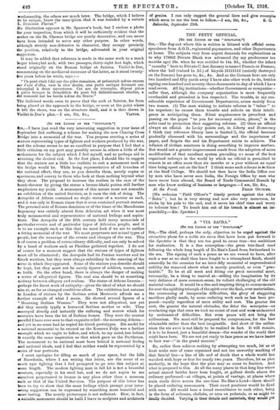"TO TES F-DITOR . 07 TER " SPECTATOR.") Ins,—I have just
read the very interesting suggestion in your issue of September 2nd outlining a scheme for making the new Charing Cross Bridge into a memorial of the war. You propose erecting a series of statues representing types of fighters and workers produced by the war, and the scheme seems to me so excellent in purpose that I feel that a little criticism on my part may possibly arouse in others a little of the enthusiasm for the subject which I feel myself, and so perhaps aid in attaining the desired end. In the first place, I should like to suggest that the statues are a little too realistic to suit a monument such as the bridge would be. While being representative of all branches of the national effort, they are, as you describe them, merely copies or specimens, and convey to those who look at them nothing beyond what they show. The proposal to increase the realism in the case of the bomb-thrower by giving the statue a bronze-khaki patina still further emphasizes my point. A monument of this nature must not resemble an exhibition of the united Services, as it runs the risk of doing. The Acropolis of Athens contained no single statue of a warrior as such, and it was only in Roman times that it even contained portrait statues. The personal note of Roman dominion or of the times of the Macedonian Begemony was entirely absent from Athenian art when it was most truly monumental and representative of national feelings and aspira- tions. The Acropolis of the fifth century held many memorials of particular events and of particular types of Athenian people, and it Is to an example such as this that we must look if we are to outline a fitting memorial of the war. We must perpetuate not actual types of people, but the meanings of the events and changes of the war. This La of course a problem of extraordinary difficulty, and can only be solved by a band of workers such as Pheidias gathered together. I do not of course for a moment suggest that the statues of types of fighters must all be eliminated ; the Acropolis had its rersian warriors and its Greek warriors, but they were always subsidiary to the meaning of the *cone in which they appeared. Some of the statues you describe should be kept, but they must not be merely figures of soldiers, nurses, and so forth. On the other hand, there is always the danger of making a series of allegorical figures. The real aim should be at something midway between allegory and realism. The statue of Athena Lemnia,— perhaps the finest work of antiquity—gives the ideal of what we should aim at, as far as changed conditions allow. The exhibition last autumn in London of statues by the Serbian artist Mestrovic affords me a further example of what I mean. He showed several figures of a " Mourning Serbian Woman." They were not allegorical, nor yet did they merely typify a bereaved Serbian mother or wife. They oonveyed directly and instantly the suffering and sorrow which for centuries have been the lot of Serbian homes. They were the nearest parallel I have ever seen to that exquisite relief—the mourning Athena— and yet in no sense had he copied his Greek prototypes. His model for • national memorial to be erected on the Kossovo Polje was a further example which we ought to follow, and which, to my mind, has behind it exactly the same inspiration as that which gave us the Parthenon. The monument to be national must have behind it national feeling and national ideals, and I feel that neither would be represented by a 'erica of war portraits.
I must apologize for filling so much of your space, but the hills of Macedonia, where I am writing this letter, are the scene of so much epic fighting that I feel prompted to go into this subject at some length. The modern fighting man in full kit is not a beautiful oreature, especially in his steel hat, and we do not aspire to see ourselves perpetuated in bronze in any place other than a museum such as that of the United Services. The purpose of this letter has been to try to show that the same feelings which prompt your inter-
e sting suggestion can be expressed by something more beautiful and more lasting. The merely picturesque is not sufficient. How, in fact, • suitable monument should be built I leave to sculptors and architects
of genius. I can only suggest the general lines and give examples which seem to me the best to follow.—I am, Sir, &c., S. (1, Salonika, September 291h.


































 Previous page
Previous page